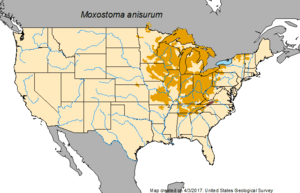Silver redhorse facts for kids
Quick facts for kids Silver redhorse |
|
|---|---|
 |
|
| Silver redhorse (Moxostoma anisurum) | |
| Conservation status | |
| Scientific classification | |
| Synonyms | |
|
The silver redhorse (Moxostoma anisurum) is a type of freshwater fish. Its name comes from Greek words meaning "mouth to suck" and "unequal tail." This fish lives only in Canada and the United States. People sometimes call it simply a redhorse or a sucker. It belongs to the Catostomidae family, which includes other sucker fish.
You can find the silver redhorse from Quebec to Alberta in Canada. In the U.S., it lives in the Mississippi River, St. Lawrence River, Ohio River, and the Great Lakes areas. The biggest silver redhorse ever caught weighed 14 pounds, 14 ounces. Chris Stephenson caught it in Alabama in 1995.
Contents
What Does the Silver Redhorse Look Like?
The silver redhorse has shiny silver sides. Its back is dark gray-brown, and its tail is slate gray. It has a large, split tail fin, called a caudal fin. Both parts of the tail fin are pointed and the same size.
On its silver sides, it has 41–42 scales along its side line. These are called cycloid lateral line scales. The fish has one dorsal fin on its back. This fin does not have sharp spines. Instead, it has 14–17 soft rays. The dorsal fin is slightly rounded outwards (convex). It sits about in the middle of the fish's back. The silver redhorse does not have an adipose fin. This is a small, soft fin found behind the main dorsal fin on some fish.
The mouth of the silver redhorse is on the bottom of its head. This is called an inferior mouth position. It helps the fish eat food from the riverbed. The back edge of its lips forms a deep "V" shape.
It is easy to confuse the silver redhorse with the Black redhorse and the Golden redhorse. But these other redhorses have dorsal fins that curve inwards (concave). They also have fewer fin rays, usually 12-14. The silver redhorse is also wider and taller than the golden or black redhorse. It usually weighs 2–5 pounds and is 18-24 inches long. Some can grow up to 10 pounds and 30 inches.
Where Do Silver Redhorse Live?
The silver redhorse naturally lives in the Great Lakes. It also lives in the St. Lawrence and Mississippi River basins. Sometimes, these fish have been found in places like Clayton Lake in North Carolina. They are common in eastern North America, from Missouri to Quebec. Many live in the southeastern United States.
These fish typically live in lakes and rivers, both small and large. They often hide under riverbanks or among tree roots that stick out into the water. They also like deep pools where the water moves slowly or not at all. These pools often have sandy bottoms. The sand is useful for burying their eggs. Silver redhorse need clean water. If the water is murky, they cannot live there. This makes them a good sign of how healthy a river or lake is.
What Do Silver Redhorse Eat?
Since its mouth is on the bottom, the silver redhorse eats food from the riverbed. It feeds on small creatures like mollusks (like snails). It also eats algae, dead plant and animal bits (called detritus), and young insects. Other tiny animals without backbones, called invertebrates, are also part of its diet. Sometimes, tiny parasites called Monogenea are found on their gills.
Silver Redhorse Life Cycle and Reproduction
Silver redhorse usually lay their eggs in the spring. This happens around April or May. The water temperature needs to be about 53 degrees Fahrenheit (12 degrees Celsius). They use shallow, fast-flowing parts of rivers called riffles. They lay their eggs at the top and bottom of these riffles, usually at night.
One study in Quebec, Canada, found many more male silver redhorse than females. For every female on the spawning bed, there are at least two males. This helps them reproduce successfully. Two males will press a female between them. This causes a vibration, and the eggs and sperm are released. The female fish buries her eggs in the gravel. After laying the eggs, the parents do not care for them.
Silver redhorse become old enough to reproduce later in life. This usually happens when they are about four to five years old. They do well in deep lakes and river systems with sandy bottoms. These places are good for their nests year after year. The silver redhorse typically lives for about 10–12 years. Some can live up to 14 years.
Silver Redhorse and People
The silver redhorse is quite common in southeastern rivers. This includes the Mississippi, Missouri, and Ohio river systems. People usually do not fish for silver redhorse for fun or for selling. This is true in most places where they live.
Right now, this fish is not a big concern for conservation. It does not need a lot of special protection or management. There might be small threats in certain areas. But overall, there are no major threats to the species. However, the silver redhorse is listed as threatened in the Strawberry River basin in Arkansas. The biggest silver redhorse caught with a rod and reel weighed 11 pounds, 7 ounces. It was caught in Plum Creek in Wisconsin in 1985.
See also
 In Spanish: Moxostoma anisurum para niños
In Spanish: Moxostoma anisurum para niños



